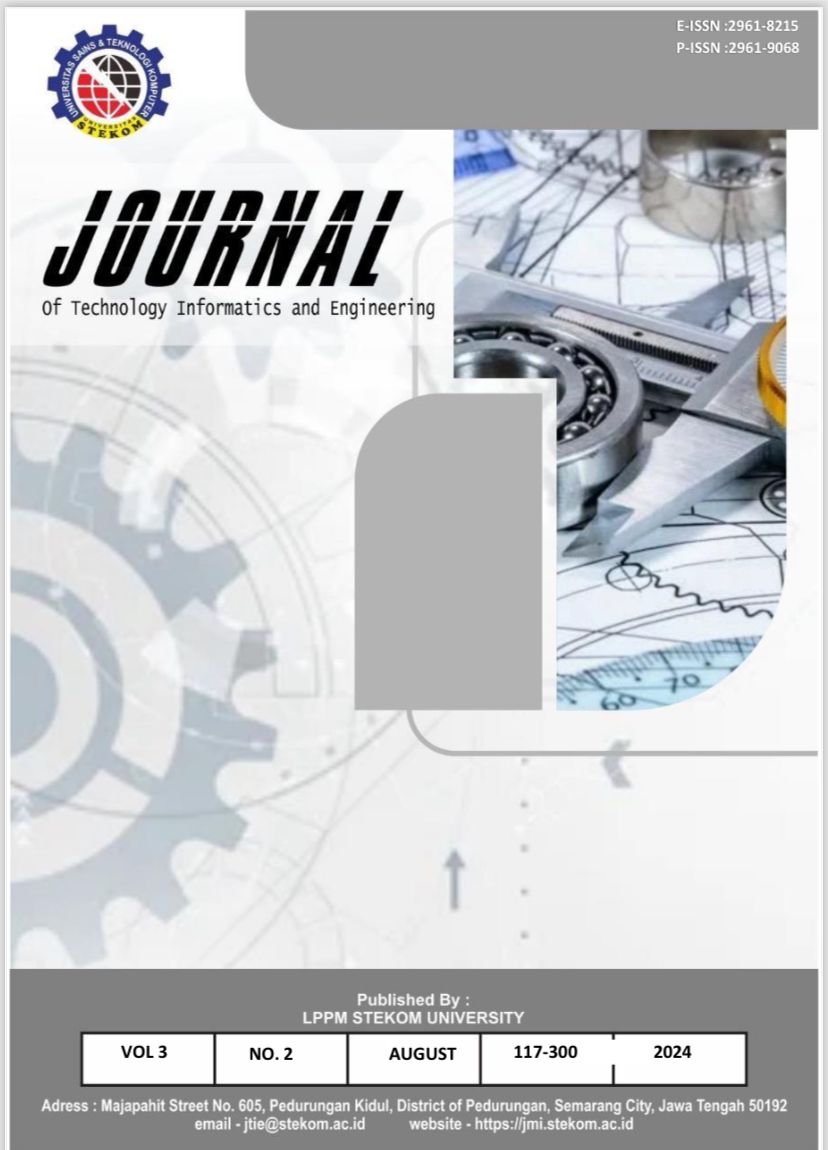Design Framework of Expert System Program in Otolaryngology Disease Diagnosis use Extreme Programming (XP)Method(Case Study in THB Bekasi Hospital)
DOI:
https://doi.org/10.51903/jtie.v3i3.209Kata Kunci:
Expert System, Extreme Programming, ENT diseaseAbstrak
The prevalence of Ear, Nose, and Throat (ENT) diseases presents diagnostic challenges, especially in resource-limited settings. At THB Bekasi Hospital, constrained specialist availability and long consultation queues highlight the need for an accessible diagnostic solution. This study aims to develop an expert system for diagnosing ENT diseases using the Extreme Programming (XP) methodology, incorporating the forward chaining technique for inference. The research includes assessment, knowledge acquisition through expert consultations, system design, and rigorous testing. The system was developed as a mobile application using Android Studio, enabling users to input symptoms and receive real-time diagnostic insights. The knowledge base integrates data from medical experts, synthesizing 11 diseases and 35 symptoms into a robust decision-making framework. The diagnostic process applies predefined rules to ensure accuracy in identifying conditions such as sinusitis, laryngitis, and otitis. Evaluation results demonstrate a 100% match accuracy during testing with 15 test cases, confirming the system’s reliability. The application offers users rapid diagnostic assistance, promoting timely treatment for ENT issues, although it does not substitute medical professionals. By leveraging ubiquitous smartphone access, this system addresses gaps in healthcare accessibility and enhances patient autonomy. This research contributes a scalable framework for deploying expert systems in other medical domains. Future improvements include integrating geolocation services for nearby specialist referrals and adopting backward chaining for more complex diagnoses, thereby broadening its applicability and utility
Referensi
Kusumadewi. 2003.Artificial Intelligent (Teknik dan aplikasinya). Edisi Pertama.Yogyakarta: Graha Ilmu.
Pressman, Roger S. 2010. Software Engineering : A Practitioner’s Approach, Seventh Edition. Mc Graw Hill Higher Education.
Safaat, Nazzarudin. 2011. Pemrograman Aplikasi Mobile Smartphone dan Tablet PC Berbasis Android. Informatika. Bandung.
Turban, E. 2005. Decision Support System and Intlegence Systems. Yogyakarta: Penerbit Andi Yogyakarta
Cambridge English Dictionary. Game. Cambridge English Dictionary Online, accessed July 27, 2018. https://dictionary.cambridge.org/dictionary/english/computer-game
Collins English Dictionary. Computer Game. Collins English Dictionary, accessed July 27, 2018. https://www.collinsdictionary.com/dictionary/english/computer-game
Wen, T., Wang, L., Gu, J., & Huang, B. (2009, June). A 3-D acceleration-based control algorithm for interactive gaming using a head-worn wireless device. In Bioinformatics and Biomedical Engineering, 2009. ICBBE 2009. 3rd International Conference on (pp. 1-3). IEEE.
Kementrian Kesehatan RI, “Situasi Penyandang Disabilitas,” Bul. Jendela Data Inf. Kesehat., vol. Semester 2, no. 1, pp. 1–5, 2014.
Song, Y., Luo, Y., & Lin, J. (2011, November). Detection of movements of head and mouth to provide computer access for disabled. In 2011 Conference on Technologies and Applications of Artificial Intelligence (pp. 223-226). IEEE.
Alhargan, A., Cooke, N., & Binjammaz, T. (2017, October). Affect recognition in an interactive gaming environment using eye tracking. In Affective Computing and Intelligent Interaction (ACII), 2017 Seventh International Conference on (pp. 285-291). IEEE.
K. Bierre, M. Hinn, T. Martin, and M. McIntosh, “Accessibility in Games: Motivations and Approaches,” … Pap. Int. Game …, 2004.
B. Yuan, E. Folmer, and F. C. Harris, “Game accessibility: A survey,” Univers. Access Inf. Soc., vol. 10, no. 1, pp. 81–100, 2011.
Palisano, R. J. (2006). A collaborative model of service delivery for children with movement disorders: a framework for evidence-based decision making. Physical Therapy, 86(9), 1295-1305.
Kumar, D., & Sharma, A. (2016, September). Electrooculogram-based virtual reality game control using blink detection and gaze calibration. In Advances in Computing, Communications and Informatics (ICACCI), 2016 International Conference on (pp. 2358-2362). IEEE.
Lu, F., Okabe, T., Sugano, Y., & Sato, Y. (2014). Learning gaze biases with head motion for head pose-free gaze estimation. Image and Vision Computing, 32(3), 169-179.
Diterbitkan
Terbitan
Bagian
Lisensi
Hak Cipta (c) 2024 Journal of Technology Informatics and Engineering

Artikel ini berlisensiCreative Commons Attribution-ShareAlike 4.0 International License.
This work is licensed under a Creative Commons Attribution-ShareAlike 4.0 International License (CC BY-SA 4.0).
This license allows others to copy, distribute, display, and perform the work, and derivative works based upon it, for both commercial and non-commercial purposes, as long as they credit the original author(s) and license their new creations under identical terms.
Licensed under CC BY-SA 4.0: https://creativecommons.org/licenses/by-sa/4.0/






